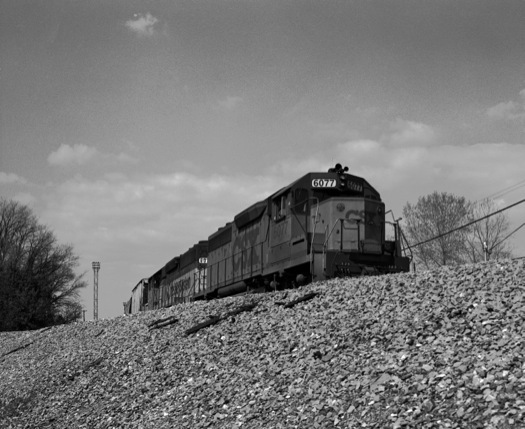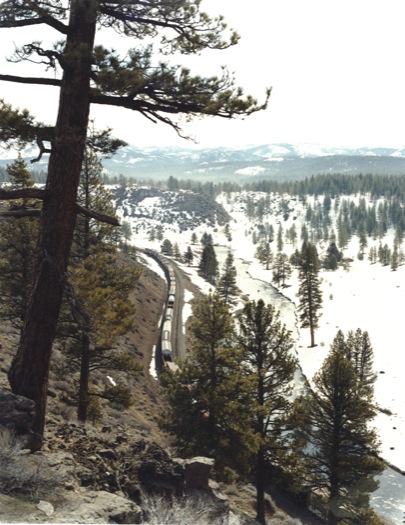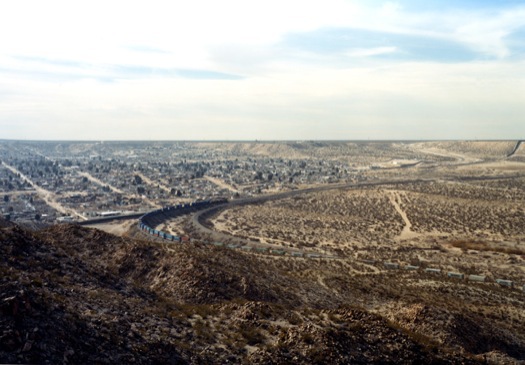
June 18, 2012
Permanent Way: An Interview with Brian Sholis

James Welling, Haggerstown, MD, 1991.
The overwhelming popularity of the High Line is a testament to the railroad’s continuing hold on our collective imagination, and its capacity to shape and frame our experience of the landscape. The camera and the railway, born of the same era, have since their earliest days encouraged us to take ownership of the physical spaces of our nation, and with varied consequences. This relationship, between the railroad, the landcape, and the mediating lens of the camera, is the subject of “Permanent Way,” a new exhibition at apexart in Tribeca, that places contemporary American railway photography in the context of historical images and documents from the nineteenth century, when the railway first made its way across the country. (The show is tied to the sesquicentennial of the Pacific Railway Act.) It’s an unusual show in that it is historical in nature but not particularly pedantic — there are no meandering wall texts — this no doubt reflecting the background of curator Brian Sholis, a former editor at Artforum and now a doctoral student in American history. In the following conversation, Sholis discusses some of the ideas, themes, and motivations of the show.
Mark Lamster: I know the show is pegged to the 150th anniversary of the Pacific Railway Act, but I’m wondering what other motivations might have prompted you to visit this subject matter now.
Brian J Sholis: In recent years I have found myself increasingly drawn to photography, and to landscape photography in particular. My writing about art is now almost exclusively about the medium, and I have reviewed exhibitions by several of the artists included in “The Permanent Way.” When I learned of Railroaded, historian Richard White’s revisionist interpretation of post–Civil War railroad development, I began working on an essay that would link recent scholarship on the subject with the photographs I had found so compelling. The invitation to organize this exhibition diverted these thoughts into another channel, but the impulse remained the same: to situate these photographs in a nonvisual historical context. I don’t think of this as an exhibition about railroads, and trainspotters may be disappointed by what they encounter when they visit. Instead, I hope to use railroads, and the anniversary of the Pacific Railway Act, as an opportunity to think about the relationship between images and the uses of the American landscape. The show also offered me a welcome personal opportunity: to bring under one roof the work I’ve done during the past decade in the contemporary-art world with my studies of American history undertaken in the PhD program at CUNY’s Graduate Center.
ML: I found this revisionist history of railway expansion particularly intriguing. The railroad was a principal actor in the development of corporate capitalism, but the meaning of that legacy is very much in question. Was it a monument of technocratic management, or a random and corrupt product of plutocracy? This seems a microcosm of an argument we’re having politically right now. Perhaps you can describe how this set of ideas shaped the images you selected.
BJS: I don’t think “or” is the best conjunction to use here — nineteenth-century American railroads were both a monument of technocratic management, as Alfred Chandler explained over three decades ago, and a corrupt product of plutocracy, a description that matches the tenor of White’s study. You’re right to notice connections to today’s political arguments, as have many historians of Gilded Age America. I’m unsure whether these viewpoints are apparent in the photographs I’ve selected. But the nineteenth-century maps I’ve chosen to reproduce demonstrate how rapidly the network of rails blanketed the United States–and the consistent inclusion of “projected roads” on the maps demonstrates the road-builders’ belief that they possessed the financial and political power to expand the web even further.

Victoria Sambunaris, Wendover, UT, 2007
I have also included late-nineteenth-century prints drawn from magazines like Harper’s Weekly and Frank Leslie’s Illustrated Newspaper. One, published in October 1877, depicts a bucolic riverside picnic scene, with a train peacefully chugging along a track on the far bank. Readers who saw this image when it was published would have had to reconcile the pastoral image with their memory of the great railroad strike that had convulsed the nation three months earlier, which was put down by militiamen and federal troops.
ML: Reconciling with the pastoral tradition is a theme that runs through the show.
BJS: It is. Like many readers, I was struck by the introduction to Leo Marx’s The Machine in the Garden when I first encountered it. Marx describes the frankly horrified responses to railroads registered by prominent American cultural figures during the 1840s. When the Pacific Railway Act was passed two decades later, locomotives were an everyday, “naturalized” part of the country’s landscape. Though trains were still a menace — fatal accidents were commonplace well into the twentieth century — they no longer played the role of villain in dramas of the American landscape. Now, when we imagine an ideal rugged American scene, there are snow-capped mountain peaks in the distance; broad, grassy plains in the foreground; and a train passing through the scene in the middle distance.

Justine Kurland, Donner Pass, 2008
ML: This calls to mind a quote by Robert Adams, one of the critical figures in the photography of the Western landscape: “All land, no matter what has happened to it, has over it a grace, an absolutely persistent beauty.” This strikes me as especially pertinent to this show, and in so many ways. There is, for instance, Justine Kurland’s image of the Donner Pass, surely a haunted landscape, but one that she presents as snow covered and harmless, or Victoria Sambunaris’s image of the US-Mexico border, which is majestic in its grandeur but covers ground that is lawless.
BJS: Adams has spent decades charting the dispiriting changes wrought upon the American West, but he’s right to insist we remain attentive to the beauty and dignity of a given place. Kurland’s photograph, like all good pictures, invites numerous interpretations. The title reminds viewers of a moment of harrowing desperation in the winter of 1846-47. The series of which it is a part is devoted to the subculture of hobos and train-hoppers. My exhibition places the picture in a different context, emphasizing the train and the rails that bisect it vertically. But, above all, it’s also a gorgeous image — something I’m glad to say I think of each of the pictures I’ve included, no matter the other reasons I selected them.

Victoria Sambunaris, Train from Cristo Rey, Sunland Park, NM, 2010
ML: How difficult was it to choose those images? The subject offers a great deal of material, with several photographic traditions (the West, the railroad) banging up against each other. Yet the show is modest in scale, just two small rooms, which I think is one of its virtues. But I’m wondering if you felt constrained, and if so what you might have added with a bit more room. Were there any artists you wanted to include but for some reason couldn’t? Or was the restriction a blessing, freeing you from the burden or temptation of a survey?
BJS: You mentioned Adams, who is a totemic figure in the history of photography, and in the history of photography of the American West. He’s among many artists I could conceivably have roped into the show. It’s such an expansive subject that the relatively small space was a blessing — not least for someone who has much more experience responding to shows than putting them together. The first decision I made was to place a kind of firewall between the artist-photographers I wanted to feature, all of whom are living, and the archival materials I wanted to include. Although there are early-twentieth-century photo postcards, there are no historical photographic prints in the show. I deliberately kept my focus narrow and used the Pacific Railway Act anniversary as my guide. I also assumed that the Museum of Modern Art’s 2009 exhibition “Into the Sunset: Photography’s Image of the American West” means that at least some of my audience will arrive at apexart having already seen a survey I admired but didn’t have the space or inclination to replicate.
ML: I kept thinking this could be the first of a trio of shows, the next on the highway act of 1956 and then one on the airplane/airport. But the show also makes a nice complement to Andrew Blum’s excellent new book, Tubes, on the physical infrastructure of the Internet. The wired network is clearly a contemporary equivalent of the rail network, and as Blum notes, the fiber-optic cabling that is the backbone of the net is laid along railroad rights of way, a kind of superimposition of networks. This convergence seems especially pertinent as the gallery sits in the shadow of the wonderful AT&T Long Distance Building, which is a major network node. The other landmark it brings immediately to mind is the High Line, the most mediated and photographed of local railroad landscapes. I wonder how you might think about it in the context of the show?
BJS: The High Line didn’t figure into my thinking for the show because of its urban location. That’s not to say that the nineteenth-century train network was exclusively, or even primarily, rural, since the nodal points were all large cities or places that hoped to become large cities. It’s just that the landscape vision of the photographers I selected is not an urban one. One way to more directly link the ideas of the show into the High Line is to consider the role Joel Sternfeld’s photographs played in gaining support for the project. The High Line’s early promoters understood the power of his “wilderness-in-the-city” photographs, and used this very persuasive bit of visual rhetoric to their advantage. So, too, did railway companies in the nineteenth century hope to use the photographs they commissioned in support of their aims to develop the American West. During the last decades of the century, a veritable flood of printed ephemera featuring landscape photographs washed over the eastern half of the United States, and even over urban centers in Europe. It entreated readers to start their lives anew in this glorious — and connected! — landscape.
ML: One final question: Was this show an intellectual exercise, or do you have some personal history with the railway or the American West that prompted you to explore this subject?
BJS: Funny you should ask that, as the exhibition is almost exclusively an intellectual exercise. Although I rode Amtrak from Chicago, where I grew up, to New York and back the summer before I turned sixteen, I don’t have extensive experience with railroads. I’d like to visit Seattle some day, but the landscape of the West has no special hold on my imagination. And I am not studying railroads or their development at the Graduate Center, where I tend to focus upon the relationships among architecture, public spaces, and politics in early twentieth century cities. Perhaps I was being opportunistic when devising the show, latching on to an anniversary I figured few others would celebrate. But now that I’ve read much of the historical literature on the subject, and had the pleasure of spending more time with photographs I had encountered only briefly, I’m extremely glad I made the choices that led to “The Permanent Way.”
“Permanent Way” runs through July 28 at apexart (291 Church Street, NYC). On July 8, Sholis will lead a New York walking tour tied to the show.
Observed
View all
Observed
By Mark Lamster
Recent Posts
A quieter place: Sound designer Eddie Gandelman on composing a future that allows us to hear ourselves think It’s Not Easy Bein’ Green: ‘Wicked’ spells for struggle and solidarity Making Space: Jon M. Chu on Designing Your Own Path Runway modeler: Airport architect Sameedha Mahajan on sending ever-more people skyward



